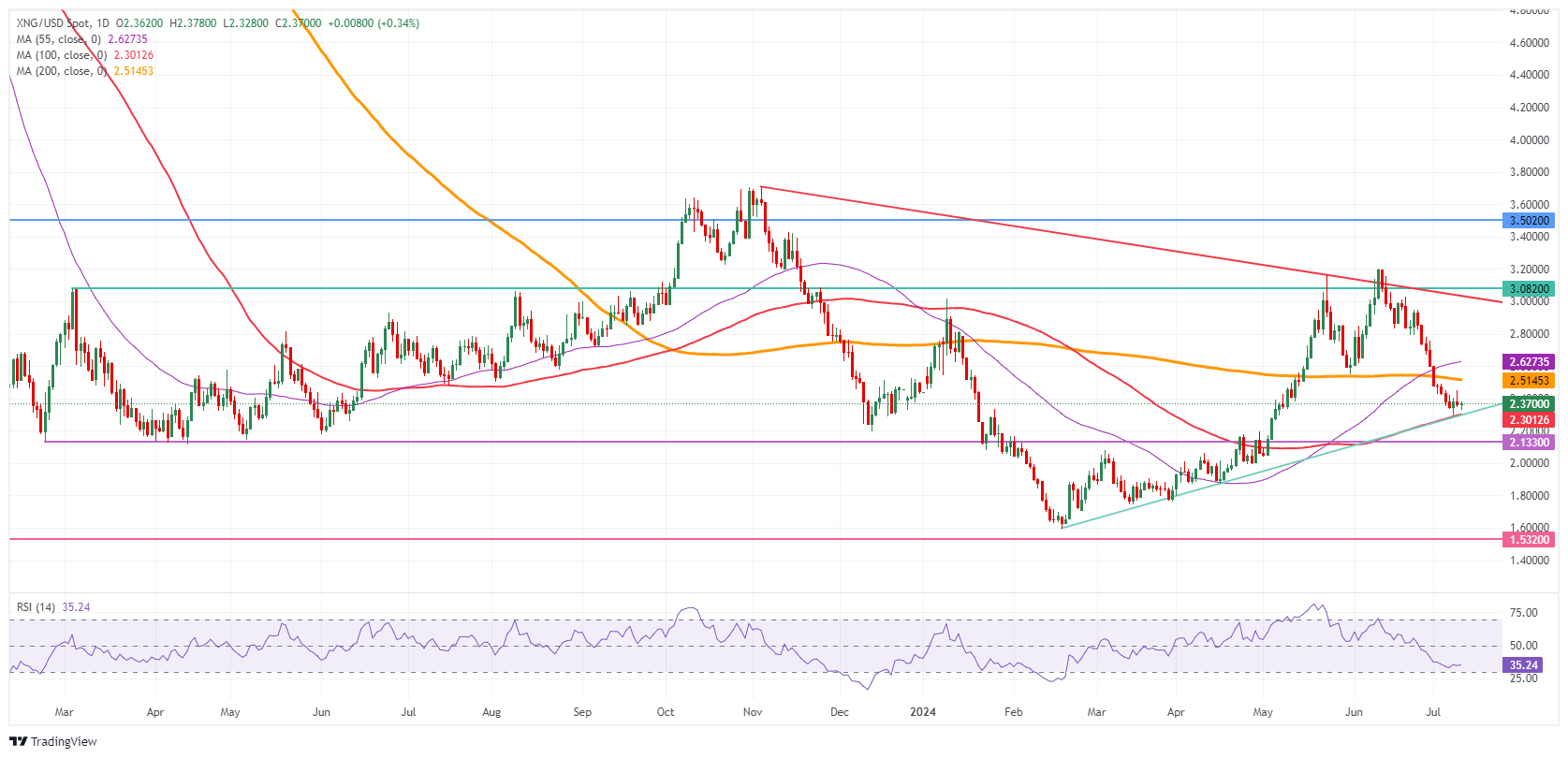- Analytics
- News and Tools
- Market News
- Natural Gas looking for direction with markets assessing Beryl’s impact
Natural Gas looking for direction with markets assessing Beryl’s impact
- Natural Gas is steady and trades sideways in a tight range.
- Traders are looking for good news out of Freeport, where production should reopen.
- The US Dollar index trades flat above 105.00 and looks for direction after a boring Powell speech.
Natural Gas price (XNG/USD) is unable to extend the bounce it triggered on Monday and trades steady in a tight range on Wednesday. The more than ten-day correction finally snapped after Natural Gas reached a pivotal level at $2.29 and has been afloat since then. Traders are on the lookout for any news from the Freeport production plant in the US after storm Beryl forced to reduce production sharply to only 20%, creating uncertainty about Gas deliveries for Europe and other parts of the world.
Meanwhile, the US Dollar Index (DXY), which tracks the Greenback’s value against six major currencies, is also having some issues. US Federal Reserve (Fed) Chairman Jerome Powell was unable to deliver anything new in his semi-annual testimony before the US Congress. Traders are facing boredom in hearing the same repeated message again that it is too early to cut interest rates.
Natural Gas is trading at $2.37 per MMBtu at the time of writing.
Natural Gas news and market movers: All eyes on US exports
- Traders are looking for clues about whether the Freeport plant in Texas can reopen back in full after it had to reduce production due to storm Beryl passing in the region, according to Reuters.
- China demand might remain curbed at current Gas prices, with Chinese traders only interested in buying contracts below $2.00, according to Bloomberg.
- Newsbase reports that the US Treasury Department has extended authorization to export and re-export Liquefied Petroleum Gas (LPG) to Venezuela until July 8, 2025.
Natural Gas Technical Analysis: More is needed for a bounce
Natural Gas price has bounced right off the support level FXStreet mentioned in previous articles at $2.29 on Monday, with the 100-day Simple Moving Average (SMA) alongside the green ascending trend line in the chart below as support. The bounce, though, is not really playing out as Gas prices are rather going sideways. Markets will await a catalyst to either retest that support again or send Gas prices higher.
The 200-day SMA is the first force to reckon with on the upside, near $2.51, closely followed by the 55-day SMA at $2.62. Once back above, the pivotal level near $3.08 (March 6, 2023, high) remains key resistance after its false break last week.
On the other hand, the support level, which could mean some buying opportunities, is $2.29, the 100-day SMA that falls in line with the ascending trend line since mid-February. In case that level does not hold as support, look for the pivotal level near $2.13, which has acted as a cap and floor in the past.
Natural Gas: Daily Chart
Natural Gas FAQs
Supply and demand dynamics are a key factor influencing Natural Gas prices, and are themselves influenced by global economic growth, industrial activity, population growth, production levels, and inventories. The weather impacts Natural Gas prices because more Gas is used during cold winters and hot summers for heating and cooling. Competition from other energy sources impacts prices as consumers may switch to cheaper sources. Geopolitical events are factors as exemplified by the war in Ukraine. Government policies relating to extraction, transportation, and environmental issues also impact prices.
The main economic release influencing Natural Gas prices is the weekly inventory bulletin from the Energy Information Administration (EIA), a US government agency that produces US gas market data. The EIA Gas bulletin usually comes out on Thursday at 14:30 GMT, a day after the EIA publishes its weekly Oil bulletin. Economic data from large consumers of Natural Gas can impact supply and demand, the largest of which include China, Germany and Japan. Natural Gas is primarily priced and traded in US Dollars, thus economic releases impacting the US Dollar are also factors.
The US Dollar is the world’s reserve currency and most commodities, including Natural Gas are priced and traded on international markets in US Dollars. As such, the value of the US Dollar is a factor in the price of Natural Gas, because if the Dollar strengthens it means less Dollars are required to buy the same volume of Gas (the price falls), and vice versa if USD strengthens.
© 2000-2025. All rights reserved.
This site is managed by Teletrade D.J. LLC 2351 LLC 2022 (Euro House, Richmond Hill Road, Kingstown, VC0100, St. Vincent and the Grenadines).
The information on this website is for informational purposes only and does not constitute any investment advice.
The company does not serve or provide services to customers who are residents of the US, Canada, Iran, The Democratic People's Republic of Korea, Yemen and FATF blacklisted countries.
Making transactions on financial markets with marginal financial instruments opens up wide possibilities and allows investors who are willing to take risks to earn high profits, carrying a potentially high risk of losses at the same time. Therefore you should responsibly approach the issue of choosing the appropriate investment strategy, taking the available resources into account, before starting trading.
Use of the information: full or partial use of materials from this website must always be referenced to TeleTrade as the source of information. Use of the materials on the Internet must be accompanied by a hyperlink to teletrade.org. Automatic import of materials and information from this website is prohibited.
Please contact our PR department if you have any questions or need assistance at pr@teletrade.global.
















